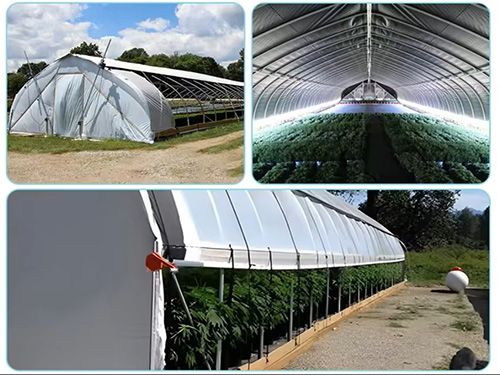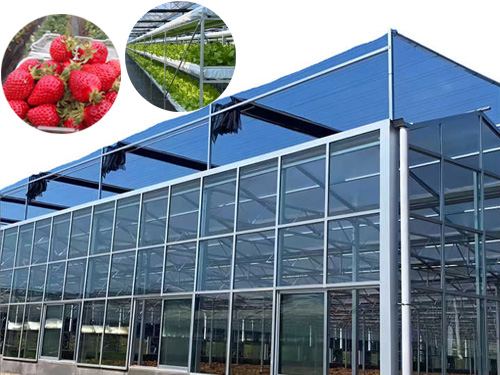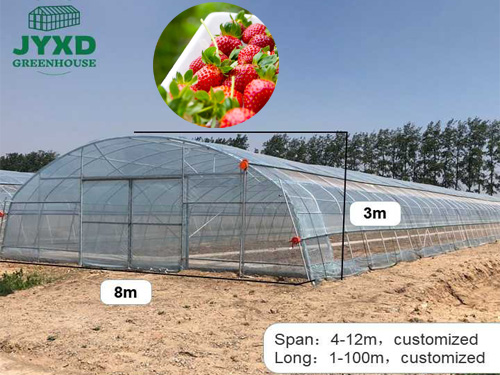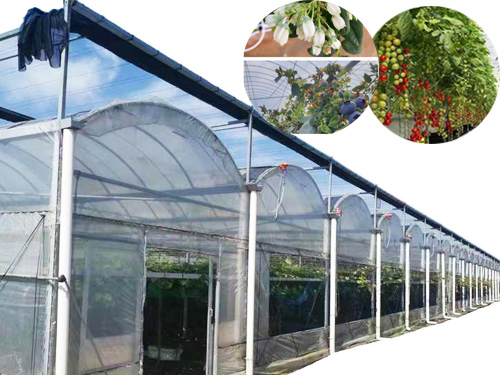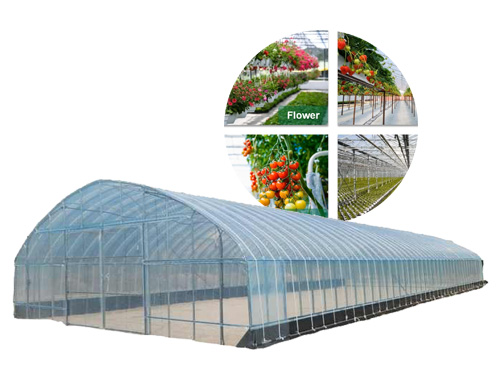NEWS DETAILS
NEWS INFORMATION
Vertical Greenhouses: Maximizing Crop Yield in Limited Space
AUTHOR:jyxd-greenhouse DATE:2025-03-26 12:20:47 HITS:148
As urbanization increases and available farmland decreases, vertical farming has emerged as a sustainable and efficient solution for growing crops in confined spaces. Vertical greenhouses, which use stacked layers of crops grown in controlled environments, offer an innovative way to maximize crop yield without needing large amounts of land. These systems are particularly beneficial for areas with limited agricultural space, such as urban centers or regions where land prices are high. In this article, we explore the benefits of vertical greenhouses, how they work, and why they are becoming an essential part of modern agriculture.
What Are Vertical Greenhouses?
Vertical greenhouses are structures designed to optimize the vertical space for growing crops. These greenhouses typically use multiple levels or tiers, where plants are grown in stacked systems rather than spread out horizontally. The plants receive the same care and environmental conditions as those in traditional greenhouses, such as controlled temperature, humidity, and lighting. However, vertical farming makes more efficient use of space by growing crops in vertical layers.
In addition to the stacking of plants, vertical greenhouses often incorporate advanced technologies such as hydroponics, aeroponics, or aquaponics to minimize the need for soil and increase efficiency. These methods use water-based solutions or air systems to deliver nutrients directly to the plants, reducing water usage and improving plant growth.
Benefits of Vertical Greenhouses
1. Maximized Space Efficiency
One of the main advantages of vertical greenhouses is their ability to maximize space. By utilizing vertical space, these systems can produce significantly higher crop yields in a smaller area. This is particularly useful in urban environments where land is scarce and expensive. Vertical greenhouses enable growers to produce food in areas that would otherwise be unsuitable for traditional farming, such as rooftops, abandoned buildings, and other underused spaces. The stacked system allows for more intensive farming, potentially increasing production by up to 10 times compared to traditional horizontal farming methods.
2. Increased Crop Yield
Vertical greenhouses allow for year-round cultivation of crops, making it possible to harvest multiple cycles per year. By controlling factors like temperature, humidity, and light, these systems can create optimal growing conditions regardless of external weather conditions. This leads to more consistent crop yields and can help ensure a steady supply of fresh produce, even in regions with harsh climates or limited growing seasons.
With the use of hydroponic or aeroponic systems, plants can receive a constant flow of nutrients, which further boosts growth rates. This is particularly beneficial for high-demand crops such as leafy greens, herbs, and microgreens, which thrive in these systems.
3. Sustainability and Resource Efficiency
Vertical greenhouses are more environmentally sustainable than traditional farming methods. By utilizing advanced farming techniques, such as hydroponics and aquaponics, vertical greenhouses use up to 90% less water compared to traditional soil-based farming. These systems recycle water through a closed-loop system, reducing waste and minimizing the environmental impact of water usage.
Furthermore, vertical farming systems require less land, which helps preserve natural ecosystems and reduces the need for deforestation. Because crops are grown indoors with controlled environments, vertical greenhouses can reduce the reliance on pesticides and herbicides, promoting cleaner, more organic food production. These eco-friendly practices align with the growing demand for sustainable agriculture.
4. Shorter Growing Cycles
Vertical greenhouses can shorten crop growing cycles due to the controlled environment and advanced cultivation techniques. By providing the ideal growing conditions, plants can reach maturity faster than they would in traditional outdoor farming. This results in quicker harvests and more efficient use of space, further boosting crop yield. As a result, growers can take advantage of multiple harvests within a single year, maximizing profitability.
5. Accessibility and Urban Farming
Vertical greenhouses are especially beneficial for urban farming initiatives. In cities where space is limited and the cost of land is high, vertical farming offers a viable solution for growing fresh food close to consumers. By growing crops in urban areas, vertical greenhouses reduce the need for transportation, which lowers carbon emissions and ensures that fresh produce reaches markets quickly. Additionally, vertical farming can provide local communities with access to healthy, sustainably grown food, helping to address food security issues in densely populated areas.
How Do Vertical Greenhouses Work?
Vertical greenhouses can take many different forms, but they typically share some common features that contribute to their efficiency. These systems rely on the use of vertical farming techniques, which include stacking crops in layers or tiers to maximize the use of space. Here’s a look at some of the technologies commonly used in vertical greenhouses:
1. Hydroponics
Hydroponics is a soil-free method of growing plants, where the plants’ roots are submerged in a nutrient-rich water solution. The water provides all the essential nutrients that plants need for growth. In vertical greenhouses, hydroponics is often used to support crop growth in stacked trays or towers. By using a closed-loop water system, vertical hydroponic farms can conserve water while promoting healthy plant growth.
2. Aeroponics
Aeroponics is another soil-free growing method where plants are suspended in air, and their roots are misted with a nutrient solution. This technique allows for optimal oxygen levels around the roots, leading to faster growth rates and higher yields. Aeroponics is especially suited for vertical greenhouses, as the system’s compact design allows for multiple layers of plants to be grown with minimal water usage.
3. Aquaponics
Aquaponics is a combination of hydroponics and aquaculture, where fish and plants are grown together in a symbiotic system. Fish waste provides nutrients for the plants, while the plants help filter and purify the water for the fish. This method not only produces crops but also raises fish, making it a highly sustainable farming system. Aquaponics is increasingly being incorporated into vertical greenhouses to create a fully integrated, sustainable food production system.
4. LED Grow Lights
Since vertical greenhouses are typically located indoors or in environments with limited natural light, the use of LED grow lights is essential for plant growth. LED lights are energy-efficient and can be customized to emit specific wavelengths of light that optimize plant photosynthesis and growth. These lights ensure that crops receive the proper amount of light, regardless of external weather conditions, and further enhance the efficiency of the vertical farming system.
Conclusion
Vertical greenhouses offer a powerful solution for maximizing crop yields in limited spaces, making them ideal for urban environments and areas with limited farmland. By utilizing innovative farming techniques such as hydroponics, aeroponics, and aquaponics, vertical greenhouses provide an efficient, sustainable way to produce food while conserving resources. As urban populations continue to grow and the demand for fresh, locally grown food increases, vertical farming will play an essential role in shaping the future of agriculture. Whether for small-scale urban farming or large-scale commercial operations, vertical greenhouses are a key part of the next generation of sustainable farming solutions.
Hebei Juyou Xinda Greenhouse Facilities Co.,Ltd.
Copyright © 2024-2025 https://www.jyxd-greenhouse.com. All Rights Reserved Hebei Juyou Xinda Greenhouse Facilities Co.,Ltd.Copyright





 Current Location:
Current Location:


